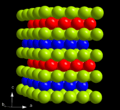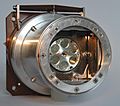Curium facts for kids
| Curium | ||||||||||||||||||||||||||||||||||||||||||||||||||||||||||||||||||||||
|---|---|---|---|---|---|---|---|---|---|---|---|---|---|---|---|---|---|---|---|---|---|---|---|---|---|---|---|---|---|---|---|---|---|---|---|---|---|---|---|---|---|---|---|---|---|---|---|---|---|---|---|---|---|---|---|---|---|---|---|---|---|---|---|---|---|---|---|---|---|---|
| Pronunciation | /ˈkjʊəriəm/ |
|||||||||||||||||||||||||||||||||||||||||||||||||||||||||||||||||||||
| Appearance | silvery metallic, glows purple in the dark | |||||||||||||||||||||||||||||||||||||||||||||||||||||||||||||||||||||
| Mass number | 247 | |||||||||||||||||||||||||||||||||||||||||||||||||||||||||||||||||||||
| Curium in the periodic table | ||||||||||||||||||||||||||||||||||||||||||||||||||||||||||||||||||||||
|
||||||||||||||||||||||||||||||||||||||||||||||||||||||||||||||||||||||
| Atomic number (Z) | 96 | |||||||||||||||||||||||||||||||||||||||||||||||||||||||||||||||||||||
| Group | n/a | |||||||||||||||||||||||||||||||||||||||||||||||||||||||||||||||||||||
| Period | period 7 | |||||||||||||||||||||||||||||||||||||||||||||||||||||||||||||||||||||
| Block | f | |||||||||||||||||||||||||||||||||||||||||||||||||||||||||||||||||||||
| Electron configuration | [Rn] 5f7 6d1 7s2 | |||||||||||||||||||||||||||||||||||||||||||||||||||||||||||||||||||||
| Electrons per shell | 2, 8, 18, 32, 25, 9, 2 | |||||||||||||||||||||||||||||||||||||||||||||||||||||||||||||||||||||
| Physical properties | ||||||||||||||||||||||||||||||||||||||||||||||||||||||||||||||||||||||
| Phase at STP | solid | |||||||||||||||||||||||||||||||||||||||||||||||||||||||||||||||||||||
| Melting point | 1613 K (1340 °C, 2444 °F) | |||||||||||||||||||||||||||||||||||||||||||||||||||||||||||||||||||||
| Boiling point | 3383 K (3110 °C, 5630 °F) | |||||||||||||||||||||||||||||||||||||||||||||||||||||||||||||||||||||
| Density (near r.t.) | 13.51 g/cm3 | |||||||||||||||||||||||||||||||||||||||||||||||||||||||||||||||||||||
| Heat of fusion | 13.85 kJ/mol | |||||||||||||||||||||||||||||||||||||||||||||||||||||||||||||||||||||
Vapor pressure
|
||||||||||||||||||||||||||||||||||||||||||||||||||||||||||||||||||||||
| Atomic properties | ||||||||||||||||||||||||||||||||||||||||||||||||||||||||||||||||||||||
| Oxidation states | +2, +3, +4, +5, +6, (an amphoteric oxide) | |||||||||||||||||||||||||||||||||||||||||||||||||||||||||||||||||||||
| Electronegativity | Pauling scale: 1.3 | |||||||||||||||||||||||||||||||||||||||||||||||||||||||||||||||||||||
| Ionization energies |
|
|||||||||||||||||||||||||||||||||||||||||||||||||||||||||||||||||||||
| Atomic radius | empirical: 174 pm | |||||||||||||||||||||||||||||||||||||||||||||||||||||||||||||||||||||
| Covalent radius | 169±3 pm | |||||||||||||||||||||||||||||||||||||||||||||||||||||||||||||||||||||
| Spectral lines of curium | ||||||||||||||||||||||||||||||||||||||||||||||||||||||||||||||||||||||
| Other properties | ||||||||||||||||||||||||||||||||||||||||||||||||||||||||||||||||||||||
| Natural occurrence | synthetic | |||||||||||||||||||||||||||||||||||||||||||||||||||||||||||||||||||||
| Crystal structure | double hexagonal close-packed (dhcp) | |||||||||||||||||||||||||||||||||||||||||||||||||||||||||||||||||||||
| Electrical resistivity | 1.25 µΩ⋅m | |||||||||||||||||||||||||||||||||||||||||||||||||||||||||||||||||||||
| Magnetic ordering | antiferromagnetic-paramagnetic transition at 52 K | |||||||||||||||||||||||||||||||||||||||||||||||||||||||||||||||||||||
| CAS Number | 7440-51-9 | |||||||||||||||||||||||||||||||||||||||||||||||||||||||||||||||||||||
| History | ||||||||||||||||||||||||||||||||||||||||||||||||||||||||||||||||||||||
| Naming | named after Marie Skłodowska-Curie and Pierre Curie | |||||||||||||||||||||||||||||||||||||||||||||||||||||||||||||||||||||
| Discovery | Glenn T. Seaborg, Ralph A. James, Albert Ghiorso (1944) | |||||||||||||||||||||||||||||||||||||||||||||||||||||||||||||||||||||
| Main isotopes of curium | ||||||||||||||||||||||||||||||||||||||||||||||||||||||||||||||||||||||
|
||||||||||||||||||||||||||||||||||||||||||||||||||||||||||||||||||||||
Curium is a chemical element. It is a radioactive metal. It has the chemical symbol Cm. It has the atomic number 96. In chemistry it is placed in a group of metal elements named the actinides. Curium is a transuranic element. It is a radioactive element that does not exist in nature. Curium has to be made in a lab. Curium has a silver color and it is made by bombarding a plutonium target with alpha particles (helium ions). Curium was named after Marie Curie and her husband Pierre.
| Periodic table | |||||||||||||||||||||||||||||||||||||||||
|---|---|---|---|---|---|---|---|---|---|---|---|---|---|---|---|---|---|---|---|---|---|---|---|---|---|---|---|---|---|---|---|---|---|---|---|---|---|---|---|---|---|
| H | He | ||||||||||||||||||||||||||||||||||||||||
| Li | Be | B | C | N | O | F | Ne | ||||||||||||||||||||||||||||||||||
| Na | Mg | Al | Si | P | S | Cl | Ar | ||||||||||||||||||||||||||||||||||
| K | Ca | Sc | Ti | V | Cr | Mn | Fe | Co | Ni | Cu | Zn | Ga | Ge | As | Se | Br | Kr | ||||||||||||||||||||||||
| Rb | Sr | Y | Zr | Nb | Mo | Tc | Ru | Rh | Pd | Ag | Cd | In | Sn | Sb | Te | I | Xe | ||||||||||||||||||||||||
| Cs | Ba | La | Ce | Pr | Nd | Pm | Sm | Eu | Gd | Tb | Dy | Ho | Er | Tm | Yb | Lu | Hf | Ta | W | Re | Os | Ir | Pt | Au | Hg | Tl | Pb | Bi | Po | At | Rn | ||||||||||
| Fr | Ra | Ac | Th | Pa | U | Np | Pu | Am | Cm | Bk | Cf | Es | Fm | Md | No | Lr | Rf | Db | Sg | Bh | Hs | Mt | Ds | Rg | Cn | Uut | Fl | Uup | Lv | Uus | Uuo | ||||||||||
|
|||||||||||||||||||||||||||||||||||||||||
Images for kids
-
Orange fluorescence of Cm3+ ions in a solution of tris(hydrotris)pyrazolylborato-Cm(III) complex, excited at 396.6 nm.
-
Chromatographic elution curves revealing the similarity between Tb, Gd, Eu lanthanides and corresponding Bk, Cm, Am actinides.
See also
 In Spanish: Curio para niños
In Spanish: Curio para niños













